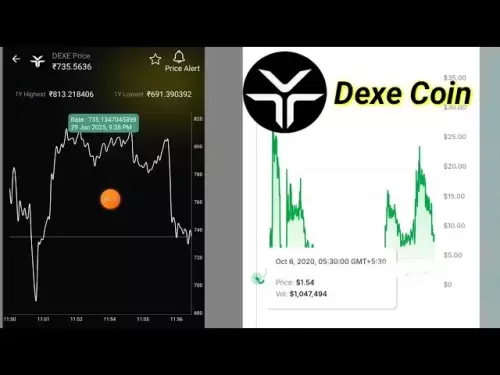-
 Bitcoin
Bitcoin $108,165.4587
0.78% -
 Ethereum
Ethereum $2,456.3517
1.15% -
 Tether USDt
Tether USDt $1.0003
0.00% -
 XRP
XRP $2.1934
0.05% -
 BNB
BNB $650.0935
0.52% -
 Solana
Solana $151.3905
2.69% -
 USDC
USDC $0.9998
0.00% -
 TRON
TRON $0.2751
-0.32% -
 Dogecoin
Dogecoin $0.1640
0.87% -
 Cardano
Cardano $0.5631
0.57% -
 Hyperliquid
Hyperliquid $38.7115
4.69% -
 Bitcoin Cash
Bitcoin Cash $493.1868
-0.39% -
 Sui
Sui $2.8217
3.61% -
 Chainlink
Chainlink $13.3994
2.08% -
 UNUS SED LEO
UNUS SED LEO $9.1632
0.94% -
 Avalanche
Avalanche $18.0318
1.97% -
 Stellar
Stellar $0.2388
0.35% -
 Toncoin
Toncoin $2.8763
1.41% -
 Shiba Inu
Shiba Inu $0.0...01160
1.59% -
 Litecoin
Litecoin $86.6393
1.29% -
 Hedera
Hedera $0.1485
0.16% -
 Monero
Monero $315.7948
1.56% -
 Polkadot
Polkadot $3.4240
1.88% -
 Bitget Token
Bitget Token $4.6314
-0.44% -
 Dai
Dai $0.9998
-0.01% -
 Ethena USDe
Ethena USDe $1.0002
-0.01% -
 Uniswap
Uniswap $7.2110
2.59% -
 Aave
Aave $270.6087
6.07% -
 Pi
Pi $0.5350
0.52% -
 Pepe
Pepe $0.0...09545
1.26%
A complete guide to digital currency trading using Coinbase
Coinbase offers a user-friendly platform for trading digital currencies, guiding users from account setup to executing trades in Bitcoin, Ethereum, and more.
Apr 03, 2025 at 10:08 am
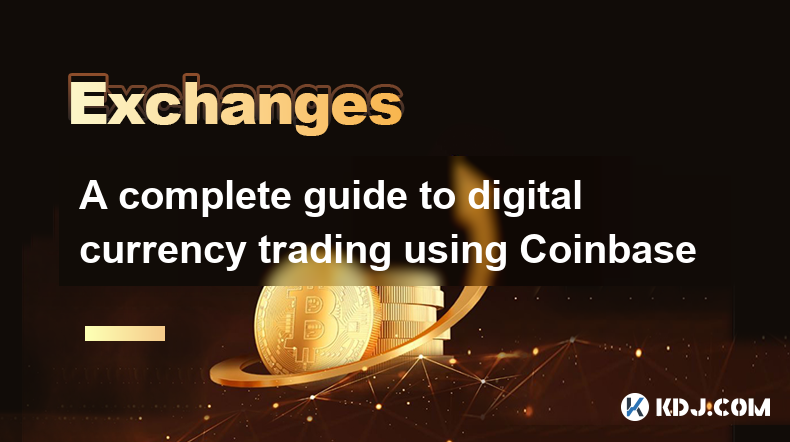
Digital currency trading has become increasingly popular, and Coinbase stands out as one of the most user-friendly platforms for both beginners and experienced traders. This guide will walk you through the process of using Coinbase to trade digital currencies, from setting up an account to executing your first trade. Whether you're looking to invest in Bitcoin, Ethereum, or any other cryptocurrency, Coinbase offers a robust platform to help you achieve your trading goals.
Getting Started with Coinbase
To begin trading on Coinbase, the first step is to create an account. Navigate to the Coinbase website and click on the "Sign Up" button. You'll need to provide your email address, create a password, and agree to Coinbase's terms of service. After signing up, you will be prompted to verify your email address. Once verified, you'll need to complete the identity verification process, which typically involves providing a government-issued ID and a selfie for security purposes.
Funding Your Coinbase Account
Before you can start trading, you'll need to fund your Coinbase account. Coinbase supports a variety of payment methods, including bank transfers, credit/debit cards, and even PayPal in some regions. To add funds, go to the "Accounts" section, select your preferred payment method, and follow the prompts to complete the transaction. It's worth noting that different payment methods may have different processing times and fees, so choose the one that best suits your needs.
Understanding the Coinbase Interface
Once your account is funded, it's time to familiarize yourself with the Coinbase interface. The main dashboard provides an overview of your portfolio, recent transactions, and market trends. The "Trade" tab is where you'll execute your trades. Here, you can select the cryptocurrency you want to buy or sell, enter the amount, and choose the order type (market, limit, or stop). The "Prices" tab offers real-time price charts and market data, which can be invaluable for making informed trading decisions.
Types of Orders on Coinbase
Coinbase offers several types of orders to cater to different trading strategies. A market order allows you to buy or sell a cryptocurrency at the current market price, ensuring immediate execution but with no control over the price. A limit order lets you set a specific price at which you want to buy or sell, providing more control but with the risk that the order may not be executed if the market doesn't reach your specified price. A stop order is used to limit losses or protect profits, triggering a market order when the price reaches a certain level.
Executing Your First Trade
To execute your first trade on Coinbase, follow these steps:
- Navigate to the "Trade" tab on the Coinbase dashboard.
- Select the cryptocurrency you want to trade, such as Bitcoin or Ethereum.
- Choose whether you want to buy or sell.
- Enter the amount you want to trade.
- Select the order type (market, limit, or stop).
- Review your order details and click "Place Order" to execute the trade.
Once the trade is executed, you'll see the transaction reflected in your portfolio and transaction history.
Managing Your Portfolio
After executing your first trade, it's important to manage your portfolio effectively. Coinbase provides tools to track your investments, including real-time price updates and performance metrics. You can also set up price alerts to notify you when a cryptocurrency reaches a certain price, helping you make timely trading decisions. Additionally, consider diversifying your portfolio to spread risk, and regularly review your investments to ensure they align with your financial goals.
Advanced Trading Features
For more experienced traders, Coinbase offers advanced features through Coinbase Pro, a more sophisticated trading platform. Coinbase Pro provides advanced charting tools, order types, and trading pairs not available on the standard Coinbase platform. To access Coinbase Pro, simply log in with your existing Coinbase credentials and explore the enhanced trading capabilities. This can be particularly useful for those looking to implement more complex trading strategies.
Security Measures on Coinbase
Security is a top priority when trading digital currencies, and Coinbase takes several measures to protect your account. Two-factor authentication (2FA) is highly recommended and can be set up through the "Settings" section of your account. Coinbase also uses cold storage to store the majority of customer funds offline, reducing the risk of hacking. Additionally, you can enable withdrawal whitelisting to ensure funds can only be sent to pre-approved addresses. Regularly reviewing and updating your security settings is crucial for maintaining the safety of your investments.
Fees and Costs
Understanding the fees associated with trading on Coinbase is important for managing your costs. Coinbase charges a fee for each transaction, which varies depending on the payment method and the size of the transaction. For example, bank transfers typically have lower fees than credit/debit card transactions. Additionally, there may be fees for converting between cryptocurrencies or withdrawing funds to a bank account. Always review the fee schedule on Coinbase's website to ensure you're aware of all potential costs.
Tips for Successful Trading
To maximize your success on Coinbase, consider the following tips:
- Stay Informed: Keep up-to-date with the latest news and trends in the cryptocurrency market. Websites like CoinDesk and CoinTelegraph can provide valuable insights.
- Start Small: If you're new to trading, start with small investments to gain experience without risking too much capital.
- Use Stop-Loss Orders: Protect your investments by setting stop-loss orders to limit potential losses.
- Diversify: Spread your investments across different cryptocurrencies to reduce risk.
- Monitor Fees: Be mindful of the fees associated with each transaction to maximize your returns.
Common Questions About Digital Currency Trading on Coinbase
Q: Is Coinbase safe to use for trading digital currencies?
A: Coinbase is considered one of the safest platforms for trading digital currencies. It employs robust security measures, including two-factor authentication, cold storage for funds, and withdrawal whitelisting. However, it's important for users to also take personal security measures, such as using strong passwords and regularly updating their security settings.
Q: What are the fees for trading on Coinbase?
A: Coinbase charges fees based on the payment method and transaction size. Bank transfers typically have lower fees than credit/debit card transactions. There are also fees for converting between cryptocurrencies and withdrawing funds to a bank account. Always check the fee schedule on Coinbase's website for the most current information.
Q: Can I trade cryptocurrencies other than Bitcoin and Ethereum on Coinbase?
A: Yes, Coinbase supports a variety of cryptocurrencies beyond Bitcoin and Ethereum, including Litecoin, Bitcoin Cash, and others. The platform regularly adds new cryptocurrencies, so it's worth checking their website for the most up-to-date list of supported assets.
Q: How do I set up a stop-loss order on Coinbase?
A: To set up a stop-loss order on Coinbase, navigate to the "Trade" tab, select the cryptocurrency you want to trade, and choose "Stop" as the order type. Enter the stop price at which you want the order to trigger, and then enter the amount you want to sell. Review your order details and click "Place Order" to set up the stop-loss order.
Q: What is the difference between Coinbase and Coinbase Pro?
A: Coinbase is designed for beginners and offers a user-friendly interface for buying and selling cryptocurrencies. Coinbase Pro, on the other hand, is aimed at more experienced traders and provides advanced trading features, including more order types, trading pairs, and charting tools. Users can access Coinbase Pro with their existing Coinbase credentials.
Disclaimer:info@kdj.com
The information provided is not trading advice. kdj.com does not assume any responsibility for any investments made based on the information provided in this article. Cryptocurrencies are highly volatile and it is highly recommended that you invest with caution after thorough research!
If you believe that the content used on this website infringes your copyright, please contact us immediately (info@kdj.com) and we will delete it promptly.
- Cryptos, Web3, Growth: What's Hot in the Streets (and on the Blockchain) for 2025
- 2025-06-30 06:30:12
- XRPL Validator Vet Sets the Record Straight: XRP, Not Your Typical US-Based Crypto
- 2025-06-30 06:30:12
- BNB, Maxwell Fork, and BSC Mainnet: Navigating Speed, Stability, and Geopolitical Tides
- 2025-06-30 06:50:12
- Qubetics, Render, Cronos: The Altcoins Poised to Pop in the Next Bull Run
- 2025-06-30 06:54:04
- Web3 AI, Bitcoin Cash, and Cardano: Crypto's Rising Stars in 2025
- 2025-06-30 06:57:13
- Bitcoin, Exchanges, and Institutions: A New Era of Crypto Dynamics
- 2025-06-30 06:35:12
Related knowledge

Binance spot market analysis: seize the best time to buy and sell
Jun 19,2025 at 04:56pm
Understanding the Binance Spot MarketThe Binance spot market is one of the most popular platforms for cryptocurrency trading globally. It allows users to trade digital assets at current market prices, making it essential for traders aiming to buy low and sell high. Unlike futures or margin trading, spot trading involves direct ownership of the asset aft...
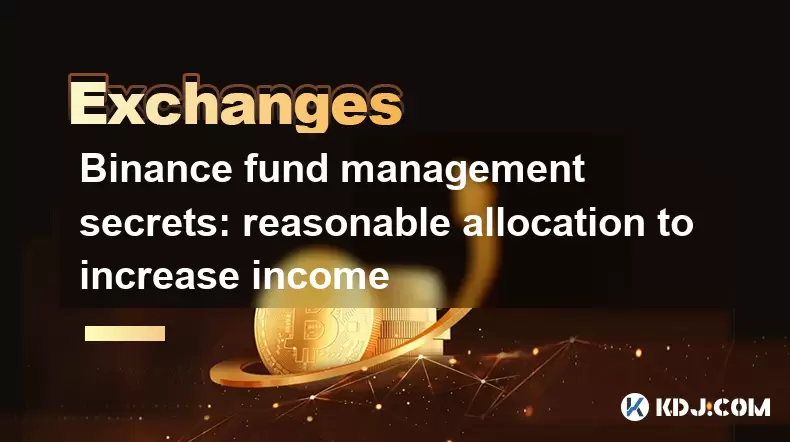
Binance fund management secrets: reasonable allocation to increase income
Jun 22,2025 at 02:29pm
Understanding Binance Fund ManagementBinance fund management involves strategic allocation of your cryptocurrency assets to optimize returns while managing risk. The key to successful fund management lies in understanding how different investment options on the Binance platform can be utilized to create a diversified portfolio. This includes spot tradin...

Binance trading pair selection skills: find the best buying and selling combination
Jun 23,2025 at 02:49am
Understanding the Basics of Trading Pairs on BinanceBefore diving into trading pair selection skills, it's essential to understand what a trading pair is. On Binance, a trading pair refers to two cryptocurrencies that can be traded against each other. For example, BTC/USDT means Bitcoin is being traded against Tether. Each trading pair has its own liqui...

Binance new coin mining strategy: participate in Launchpool to earn income
Jun 23,2025 at 11:56am
What is Binance Launchpool and how does it work?Binance Launchpool is a feature introduced by the world’s largest cryptocurrency exchange, Binance, to allow users to earn new tokens through staking. This platform enables users to stake their existing cryptocurrencies (such as BNB, BUSD, or other supported assets) in exchange for newly launched tokens. T...
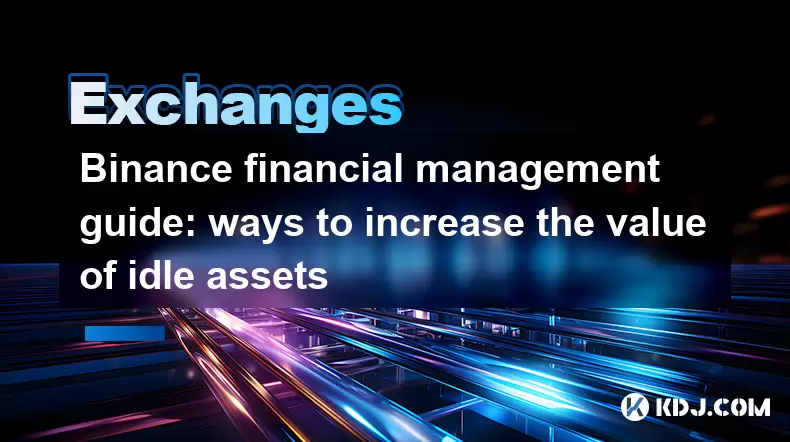
Binance financial management guide: ways to increase the value of idle assets
Jun 19,2025 at 11:22pm
Understanding Idle Assets in the Cryptocurrency SpaceIn the fast-paced world of cryptocurrency, idle assets refer to digital currencies that are not actively being used for trading, staking, or yield farming. Holding these funds in a wallet without utilizing them means missing out on potential growth opportunities. Binance, as one of the leading platfor...
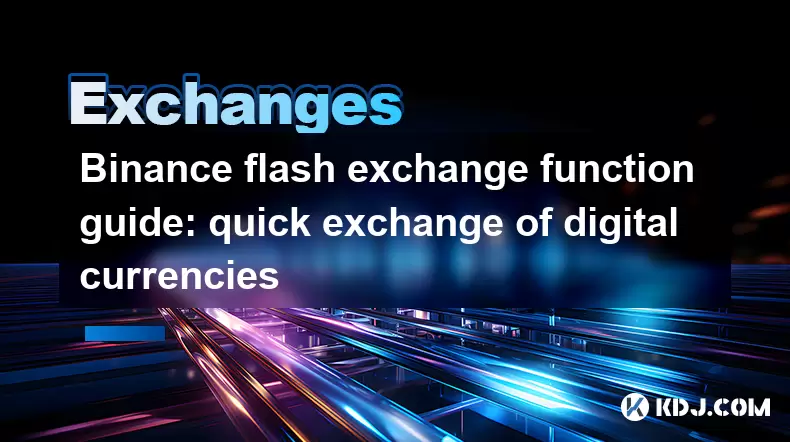
Binance flash exchange function guide: quick exchange of digital currencies
Jun 23,2025 at 12:29pm
What is the Binance Flash Exchange Function?The Binance Flash Exchange function is a powerful tool designed to allow users to instantly swap between supported cryptocurrencies without the need for placing traditional buy/sell orders. This feature simplifies the trading process by offering a direct exchange mechanism, eliminating the requirement to conve...

Binance spot market analysis: seize the best time to buy and sell
Jun 19,2025 at 04:56pm
Understanding the Binance Spot MarketThe Binance spot market is one of the most popular platforms for cryptocurrency trading globally. It allows users to trade digital assets at current market prices, making it essential for traders aiming to buy low and sell high. Unlike futures or margin trading, spot trading involves direct ownership of the asset aft...

Binance fund management secrets: reasonable allocation to increase income
Jun 22,2025 at 02:29pm
Understanding Binance Fund ManagementBinance fund management involves strategic allocation of your cryptocurrency assets to optimize returns while managing risk. The key to successful fund management lies in understanding how different investment options on the Binance platform can be utilized to create a diversified portfolio. This includes spot tradin...

Binance trading pair selection skills: find the best buying and selling combination
Jun 23,2025 at 02:49am
Understanding the Basics of Trading Pairs on BinanceBefore diving into trading pair selection skills, it's essential to understand what a trading pair is. On Binance, a trading pair refers to two cryptocurrencies that can be traded against each other. For example, BTC/USDT means Bitcoin is being traded against Tether. Each trading pair has its own liqui...

Binance new coin mining strategy: participate in Launchpool to earn income
Jun 23,2025 at 11:56am
What is Binance Launchpool and how does it work?Binance Launchpool is a feature introduced by the world’s largest cryptocurrency exchange, Binance, to allow users to earn new tokens through staking. This platform enables users to stake their existing cryptocurrencies (such as BNB, BUSD, or other supported assets) in exchange for newly launched tokens. T...

Binance financial management guide: ways to increase the value of idle assets
Jun 19,2025 at 11:22pm
Understanding Idle Assets in the Cryptocurrency SpaceIn the fast-paced world of cryptocurrency, idle assets refer to digital currencies that are not actively being used for trading, staking, or yield farming. Holding these funds in a wallet without utilizing them means missing out on potential growth opportunities. Binance, as one of the leading platfor...

Binance flash exchange function guide: quick exchange of digital currencies
Jun 23,2025 at 12:29pm
What is the Binance Flash Exchange Function?The Binance Flash Exchange function is a powerful tool designed to allow users to instantly swap between supported cryptocurrencies without the need for placing traditional buy/sell orders. This feature simplifies the trading process by offering a direct exchange mechanism, eliminating the requirement to conve...
See all articles





















